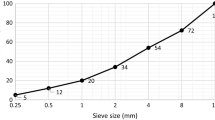Abstract
This paper presents the findings of an experimental program seeking to understand the effect of mineral admixtures on fresh and hardened properties of sustainable self-consolidating concrete (SCC) mixes where up to 80% of Portland cement was replaced with fly ash, silica fume, or ground granulated blast furnace slag. Compressive strength of SCC mixes was measured after 3, 7, and 28 days of moist curing. It was concluded in this study that increasing the dosage of fly ash increases concrete flow but also decreases segregation resistance. In addition, for the water-to-cement ratio of 0.36 used in this study, it was observed that the compressive strength decreases compared to control mix after 28 days of curing when cement was partially replaced by 10%, 30%, and 40%of fly ash. However, a fly ash replacement ratio of 20% increased the compressive strength by a small margin compared to the control mix. Replacing cement with silica fume at 5%, 10%, 15%, and 20% was found to increase compressive strength of SCC mixes compared to the control mix. However, the highest 28 day compressive strength of 95.3 MPa occurred with SCC mixes in which 15% of the cement was replaced with silica fume.
Similar content being viewed by others
References
Hannesson G, Kuder K, Shogren R, Lehman D. The influence of high volume of fly ash and slag on the compressive strength of selfconsolidating concrete. Construction & Building Materials, 2012, 30: 161–168
El-Chabib H, Syed A. Properties of self-consolidating concrete made with high volumes of supplementary cementitious materials. Journal of Materials in Civil Engineering, 2013, 25(11): 1579–1586
Shaikh F U A, Supit S W M. Compressive strength and durability properties of high volume fly ash (HVFA) concretes containing ultrafine fly ash (UFFA). Journal of Construction and Building Materials, 2015, 82: 192–205
Kim H K, Lee H K. Effects of high volume fly ash, blast furnace slag, and bottom ash on flow characteristics, density, and compressive strength of high-strength mortar. Journal of Materials in Civil Engineering, 2013, 25(5): 662–665
Naik T R, Singh S S. Superplasticized structural concrete containing high volumes. Journal of Energy Engineering, 1992, 117(2): 87–96
Rashad AM. Potential use of silica fume coupled with slag in HVFA concrete exposed to elevated temperatures. Journal of Materials in Civil Engineering, 2015, 27(11): 04015019
Mohamed O A, Rens K L, Stalnaker J J. Time effect of alkaliaggregate reaction on performance of concrete. Journal of Materials in Civil Engineering, 2001, 13(2): 143–151
Yazdani N, Filsaime M, Islam S. Accelerated curing of silica fume concrete. Journal of Materials in Civil Engineering, 2006, 20(8): 521–529
Bingöl A F, Tohumcu I. Effects of different curing regimes on the compressive strength properties of self-compacting concrete incorporating fly ash and silica fume. Materials & Design, 2013, 51: 12–18
ASTM C 1611M. Standard test method for slump flow of selfconsolidating concrete. 2014
Boukendakdi O, Kenai S, Kadri E H, Rouis F. Effect of slag on the rheology of fresh self-compacted concrete. Construction & Building Materials, 2009, 23(7): 2593–2598
Mazloom M, Ramezanianpour A A, Brooks J J. Effect of silica fume on mechanical properties of high-strength concrete. Cement and Concrete Composites, 2004, 26(4): 347–357
Elahi A, Basheer PA M, Nanukuttan S V, Khan Q U Z. Mechanical and durability properties of high performance concretes containing supplementary cementitious materials. Construction & Building Materials, 2010, 24(3): 292–299
Oner A, Akyuz S. An experimental study on optimum usage of GGBS for compressive strength of concrete. Cement and Concrete Composites, 2007, 29(6): 505–514
Acknowledgements
The authors wish to acknowledge the financial support of the Office of Research and Sponsored Programs at Abu Dhabi University through grant # 1920200.
Author information
Authors and Affiliations
Corresponding author
Rights and permissions
About this article
Cite this article
Mohamed, O.A., Najm, O.F. Compressive strength and stability of sustainable self-consolidating concrete containing fly ash, silica fume, and GGBS. Front. Struct. Civ. Eng. 11, 406–411 (2017). https://doi.org/10.1007/s11709-016-0350-1
Received:
Accepted:
Published:
Issue Date:
DOI: https://doi.org/10.1007/s11709-016-0350-1




